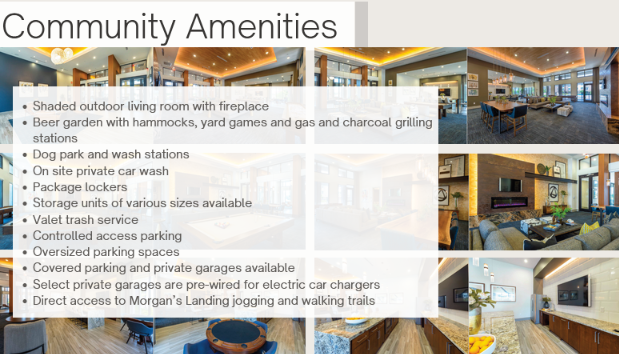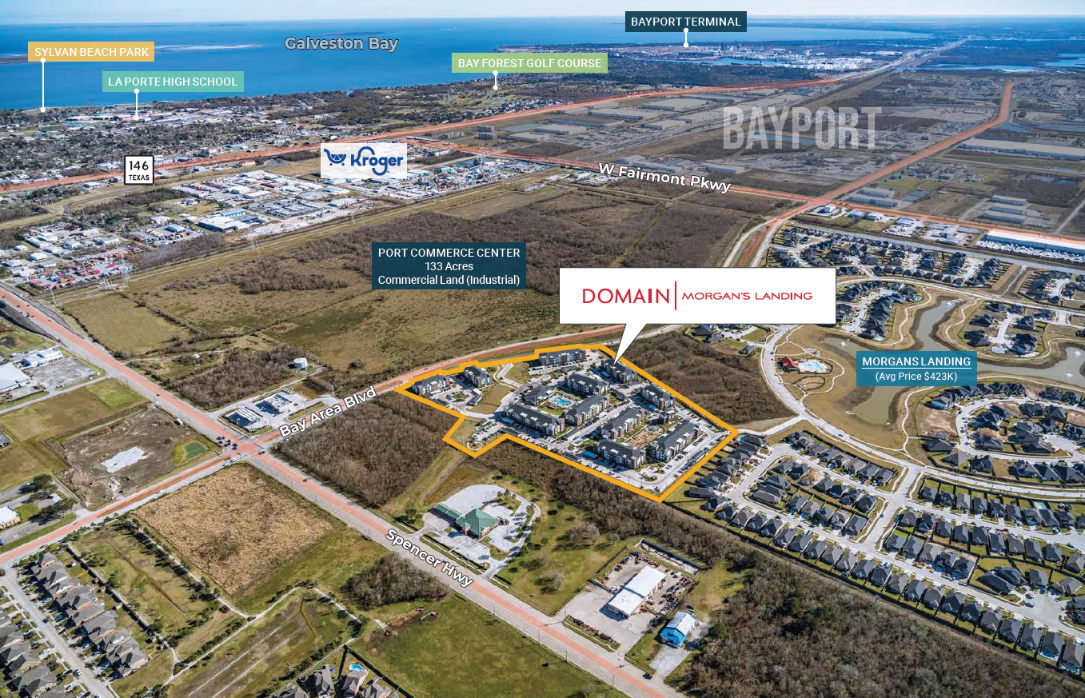
Domain at Morgan’s Landing is the newest multifamily asset in one of Houston’s rare barriers-to-entry suburbs. Only nine conventional multifamily properties have been built in the submarket since 2000 due to strict zoning restrictions. As an institutional quality property built to best-in-class standards, Domain at Morgan’s Landing quickly stabilized in the underserved market. The low-density, garden-style community is available at an attractive basis to replacement cost, offering investors a highly differentiated asset with no true competitors and no new supply in a job-rich environment.
Investment Highlights Best-in-Class Product: Domain at Morgan’s Landing reset the standards in its submarket, offering amenities and a quality of interior finishes previously unavailable in the market
Rapid Lease-Up: Averaged 27 new leases a month in 2021 and average leased rent increased from $1,315 in January to $1,524 in December
Immediate Income Upside: New ownership can turn the majority of first generation leases in an improved economic environment
Zero New Multifamily Supply: No new construction within an 8-mile radius of Domain at Morgan’s Landing
Strong Multifamily Rent Growth: 9.7% T12 rent growth in submarket and 9.7% rent growth projected for 2022 (Axiometrics)
Limited Single-Family Inventory: Only 3 homes available in adjacent neighborhood and 74 total in city with 31% year-over-year increased pricing
Job-Rich Environment: 35K jobs within 5 miles and 193K jobs within 10 miles, anchored by healthy and high-paying manufacturing, industrial, and petrochemical industries
Bayport Proximity: Substantial job generators nearby including the Bayport Industrial District (15K jobs) and Bayport Terminal of the Port of Houston (225K jobs), both with multi- billion-dollar expansions underway
High Wages: Median household income in the area is $75K, or 77% higher than the City of Houston and 10% higher than the Houston metro
Property Details Domain at Morgan’s Landing is in Laporte TX, which is home to more than 35,000 residents. The location of the community allows residents convenient access to Highway 146 and 225. This newly constructed community is a 3 story garden style property that consists of one, two and three bedroom floorplans totaling 350 units with state of the art amenities. The community is easy to locate and stands out with a large monument sign and beautifully landscaped winding entrance. Domain at Morgan’s Landing sets in a prime location with award winning schools, state of the art library, spacious parkland, and ease of access to Houston Ship Channel, Galveston Bay, downtown Houston, and Kemah Boardwalk. The city of La Porte is home to some of the largest petrochemical industries thanks to the Barbour’s cut Terminal and Bayport Terminal operated by the Port of Houston.


Invest NowApartment Features3-story townhomes with attached garages available
Pool and courtyard views*
Pre-wired for high speed internet
9-foot ceilings
Crown molding
Foyer coat closets
Wood-grain flooring in kitchens and living areas
Two-inch faux wood blinds
Expansive living areas
Ceiling fans in living rooms and bedrooms
Kitchen pantries
Granite countertops
Under cabinet lighting and tiled backsplash
USB ports
Stainless steel appliances
Side-by-side refrigerators w/ in-door water/ice dispensers*
Wine chillers*
Kitchen islands and 42” cabinetry
Single-basin undermount sinks with gooseneck faucets
Brushed nickel hardware and fixtures
Track and pendant lighting
Carpeted bedrooms
Spacious walk-in closets
Spacious, spa-inspired bathrooms with ceramic tile
Framed mirrors
Dual shower heads*
Dual vanities*
Walk-in showers*
Garden-style soaking tubs with curved shower rods
Linen closets
Full-size washers and dryers included
Private balconies and patios
Private yards*
Location Domain at Morgan’s Landing is located in the heart of La Porte, one of the well- known and livable municipalities in Southeast Houston. The community is well-positioned for access to local area employment and lifestyle amenities, as well convenient accessibility to major employers and destinations in Deer Park, Baytown, Pasadena, and Clear Lake.


















